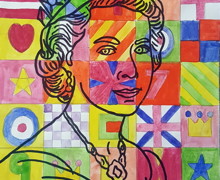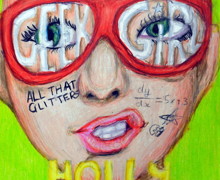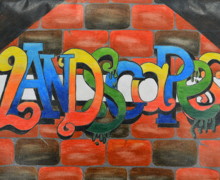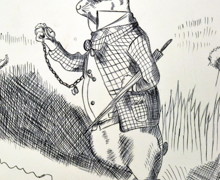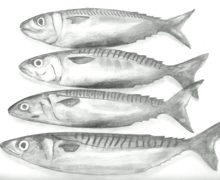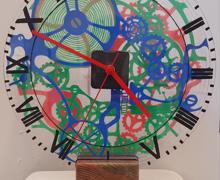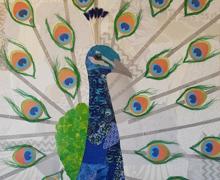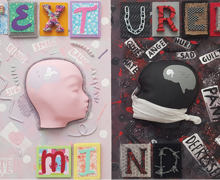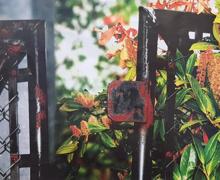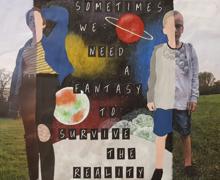- Home
- Secondary
- Subject Information
Art
BackIntroduction
Art lessons embody some of the most creative types of learning. Our aim is to engage, inspire and challenge pupils, whilst encouraging the development of independent learners. Students will become equipped with the knowledge and skills needed to experiment, invent and create their own works of art, craft and design, whilst extending their confidence to take creative risks.
We have created a well-resourced and stimulating environment within our three specialist classrooms, where success and achievement are valued and celebrated.
Aims
- To produce creative, imaginative and personal work, exploring their ideas and recording their experiences through observation and experimentation.
- To become proficient in drawing, painting, printing, sculpture, photography and other art, craft and design techniques.
- To evaluate and analyse creative works using the language of art, craft and design, using CoProFoMo (Content, Process, Form and Mood) and the formal elements of line, shape, form, tone, texture, pattern, colour and composition.
- To know about great artists, craft makers and designers, art movements and styles and understand the historical and cultural development of their art forms.
The Art department has high expectations of our students’ attainment, development and personal conduct and promotes learning that supports the perception and understanding of spiritual, moral, social, cultural and emotional issues within a visual context.
Art is part of the core curriculum at Key Stage 3 with both Art and Photography options available at GCSE.
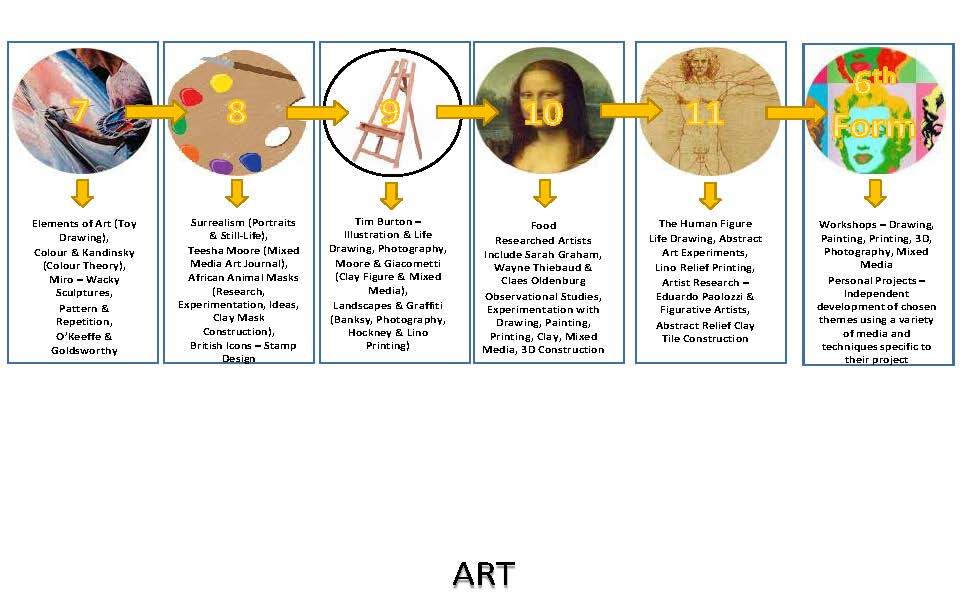

KS3
At Tabor, Key Stage 3 provides a very broad range of creative options and encourages students to become independent creative artists. We believe that to realise the full potential of our students, they need to be introduced to diverse disciplines as soon as possible whether it is basic mark-making on paper, the flexibility of constructing with cardboard, wire or clay, or simply producing pieces of art on a huge and challenging scale. Each year will include a multitude of options, based on selected themes, designed to give each student a clear idea of their own creative strength.
Students experience Art for 1 hour per week during Key Stage 3 and we regularly assess throughout each project, providing feedback to facilitate further development and progress. All students complete a baseline assessment at the beginning of each term, assessing observational drawing skills and the handling of different media. These levels are recorded and monitored for progress. Students are expected to complete one homework on a 2 weekly basis.
Students will work practically in a sketchbook throughout the year, as well as creating larger 2D and 3D responses outside of their book, covering the skills of investigating artists and materials, recording observations and ideas, creating a personal response and evaluating and reflecting on their work and the work of others. This work will show understanding of the formal Art elements of colour, form, tone, texture, pattern, shape, space and line. Written annotation, analysis and evaluation will feature within their work.
Throughout Key Stage 3 there will be opportunities to visit museums and galleries to see art work first hand, such as The Fitzwilliam Museum in Cambridge and The Henry Moore Foundation in Hertfordshire.
|
|
Year 7 |
Year 8 |
Year 9 |
|
Autumn |
Baseline Assessment - Pencil Drawing Elements of Art – Mark-Making & Tonal Shading Techniques, Pencil Toy Drawing Colour - Colour Wheel & Theory Wassily Kandinsky - Painting to Music |
Baseline Assessment - Pencil Drawing Surrealism - Artist Research & Observational Studies Portraits - Proportion & Features Surreal Portraits - Ideas & Personal Response Surreal Still-Life - Ideas & Personal Response Teesha Moore - Mixed Media Art Journal |
Baseline Assessment - Pencil Drawing Tim Burton Illustration - Artist Research & Observational Studies Life Drawing - Shape & Proportion Illustration in Burton’s Style – Ideas, Pen & Ink/Watercolour Personal Studies |
|
Spring |
Baseline Assessment – Pen Drawing Whacky Sculptures – Joan Miro research, 3D Design & Construction Pattern & Repetition – Symmetry & Observational Studies Sgraffito - Pattern Experiments Beetles – Artist Studies & Print Designs |
Baseline Assessment – Pen Drawing African Animal Masks - Research & Observational Studies Mask Experiments - Development of Mask Ideas African Animal Clay Mask Construction - Shape, 3D Form, Colour & Pattern |
Baseline Assessment – Pen Drawing Henry Moore & Alberto Giacometti - Negative Space, Observational & Mixed Media Studies Design Ideas - Shape & Proportion Reclining Figure Personal Response - Inspired by Henry Moore Giacometti Inspired Figures -Ideas & Personal Response |
|
Summer |
Baseline Assessment - Watercolour Painting Poly Block Printing - Mixed Media & Collage Georgia O'Keeffe - Flowers and Skulls Andy Goldsworthy - Land Art Research & Creation |
Baseline Assessment - Watercolour Painting British Icons - Bus, Stamp, Phone & Post Box, Research Artist Studies - Riley, Hirst, Gilbert & George, Blake Stamp Creation - Design & Personal Response Photoshop - Digital Experiments |
Baseline Assessment – Watercolour Painting Landscapes - Graffiti, Street, Urban & Rural Landscape Photography, Research & Presentation Banksy & David Hockney - Development of Ideas & Personal Response |
KS4
At Key Stage 4 students currently follow the AQA exam board specification. Two subjects are currently offered as options for students who wish to continue their study of Art to GCSE; Art and Photography.
Students experience Art or Photography for 3 hours per week during Key Stage 4 and we regularly assess throughout each project, providing feedback and one to one tutorials to facilitate further development and progress. Students will be expected to undertake regular independent learning at home and Year 11 will feature a mock examination toward the latter part of the autumn term.
How is GCSE Art and Photography assessed/examined?
Unit 1: Personal Portfolio (Coursework unit) – 60% of the final grade.
This will comprise of a sketchbook and other supporting studies. Students will research and analyse a range of artists and photographers, work from observation, develop ideas with clear annotation and drawings, and experiment with media and techniques which will lead to a range of personal responses.
Unit 2: Externally set Assignment (Controlled test) – 40% of the final grade.
The theme of this unit is set by the exam board. Students have a minimum of 20 hours preparation time followed by an unaided 10 hour exam on a final piece. This follows a similar format to coursework but over a considerably shorter time.
In both cases, work will be assessed against four assessment objectives as follows:
Assessment Objective 1: Develop ideas through investigations, demonstrating critical understanding of sources.
Assessment Objective 2: Refine work by exploring ideas, selecting and experimenting with appropriate media, materials, techniques and processes.
Assessment Objective 3: Record ideas, observations and insights relevant to intentions as work progresses.
Assessment Objective 4: Present a personal and meaningful response that realises intentions and demonstrates understanding of visual language.
Students’ work will be internally assessed by teachers in the Art department. A sample will then be selected by the exam board which will be assessed by an external moderator.
GCSE Art
We follow a course that allows students to work in any materials/style they wish. GCSE Art is a creative course that allows students to explore the formal elements within Art through themes and the creative responses of historical and contemporary artist/designers.
Strong observational drawing skills underpin each project and act as a foundation for the successful development of further skills and experimentation. All students will be expected to complete in-depth analysis of the work of artists and designers using the CoProFoMo structure (Content, Process, Form and Mood) as well as independent learning tasks.
We encourage our students to visit galleries, exhibitions and arts events that will inform their learning; a visit to the Tate Modern or Britain in London will be incorporated into the course.
In year 10 we immerse our students within the creative process, exploring in depth themes and topics through personal, creative exploration of media, processes and techniques. The recording and development of these processes is sketchbook based, making them invaluable and sophisticated documents showing the routes taken to final outcomes.
Students begin by studying and analysing the work of artists and designers linked to the theme of ‘Food’, such as Sarah Graham, Wayne Thiebaud, Emma Dibben and Claes Oldenburg. Responses to their work are created using a wide variety of 2D and 3D approaches and techniques including clay, sculpture, printmaking, acrylic and watercolour painting, mixed media and collage.
In year 11 our students will complete a self-led project that showcases their understanding of processes and techniques on the theme of ‘The Human Figure’. The research and analysis of various figurative artists will further inspire ideas towards expressive and possibly abstract outcomes using lino printing, drypoint etching, and other media and approaches of their choice.
The externally set examination will begin in the Spring term of year 11.
GCSE Photography
Photography is an increasingly popular choice at GCSE, allowing students to capture and create images using a range of photographic techniques and processes, whilst experimenting with digital and manual editing.
Students will be given the opportunity to:
- Research a wide range of different photographers and the history of photography.
- Analyse photographic work in depth using specialist vocabulary.
- Take effective photographs using a digital SLR camera.
- Find out how to use photographic equipment within a darkroom.
- Find out how to change and improve photographs using digital manipulation software such as Photoshop.
- Experiment creatively with mixed media techniques, with annotation and drawing to show the development of their ideas.
The emphasis will be placed on the student to be independent and take responsibility for their learning and creative practice. This, coupled with the practical and theoretical skills they will gain during the course, will provide students with a solid base for any future pathway within Photography.
We encourage our students to visit galleries, exhibitions and arts events that will inform their learning; a visit to the Victoria and Albert Museum or The Photographers’ Gallery in London will be incorporated into the course.
In year 10 students will first be introduced to the ‘Rules of Composition’ and the powerful effect that elements such as symmetry, rule of thirds, leading lines and space can have on creating a successfully composed photograph. Projects looking at the technical aspects of aperture and shutter speed follow, allowing for the creation of exciting ‘light paintings’ inspired by Picasso.
In the Spring term the ‘History of Photography’ will be studied and students will have the opportunity to create pin hole cameras and ‘Rayographs’ in the dark room. Sarah Graham’s sweet compositions, and the thought provoking and often humorous photographer Slinkachu will then be studied with outcomes produced which demonstrate an understanding of how to use rules of composition, aperture and shutter speed effectively.
The final projects of the Summer term will look at ‘Portraiture’, experimenting with a variety of approaches to, and styles of, portrait photography, leading to the development of creative ideas for a magazine cover incorporating a striking portrait image.
In year 11 students will further develop their photography knowledge and skills with a mixed media focus. Images will be altered and manipulated both digitally and manually using a variety of techniques including painting, tearing, layering and stitching, and artists including Joe Cruz, Lorena Cosba and Amy Friend will be researched and analysed, leading to further experiments and development of ideas towards an exciting personal response.
The externally set examination will begin in the Spring term of year 11.
Equipment
KS3
To be fully prepared for your Art lessons you will need to bring the following equipment:
- Pencils to draw with.
- A good rubber and pencil sharpener.
- A ruler.
- A black pen.
- A good selection of coloured pencils.
If you have any other Art equipment that you would like to bring into lessons, such as pastels, paints and brushes, you are more than welcome when appropriate.
KS4 Art
You will be expected to work in a wider range of media with more experimental techniques. All equipment and resources will be provided, however the following items would be useful in addition to the list above:
- A3 sketchbook (can be purchased through the Art department).
- A set of sketching pencils of different grades e.g. 2B, 4B and 6B.
- A set of watercolour paints with appropriate brushes.
- A set of acrylic paints with appropriate brushes.
- A set of oil pastels/soft pastels.
- Black fineliner pen.
KS4 Photography
- A3 black paper sketchbook (can be purchased through the Art department).
- White gel pen or white pencil (for writing on black paper in your sketchbook).
- SDHC card (for use in DSLR cameras).
- SDHC card reader.
- USB memory stick (for saving work).
- Glue stick.
- Access to photographic quality printing outside of school.
Students’ own cameras can also be brought into school and used in Photography lessons.
Extra curricular
We will be offering a range of enrichment opportunities throughout the academic year with multi-disciplinary learning experiences for our students. Clubs, such as the following, will be on offer:
- KS3 Art
- Mosaics
- KS4 Art
- KS4 Photography
There will also be the opportunity for other activities such as working with visiting artists/designers, workshops, gallery visits, whole school productions and exhibitions.
Useful Links
Art is a demanding and challenging subject which is enhanced through independent and personal engagement. Regular visits to as many exhibitions and galleries as possible would be hugely beneficial, as well as viewing art centred documentaries or programmes on television. However, the most important support we would recommend is regular viewing and discussion of the sketchbook – encouraging your child to discuss what they are learning and the artists/themes they are studying.
Useful links
- www.artchive.com
- www.sfmoma.org
- www.somersethouse.org.uk
- www.tate.org.uk
- www.theaoi.com
- www.thelowry.com
- www.vam.ac.uk
- www.walkerart.org
- www.whitecube.com
- www.artguide.org
- www.artnet.com
- www.artsmia.org
- www.britishmuseum.org/
- www.craftscouncil.org.uk
- www.designmuseum.org/
- www.guggenheim.org
- www.iconeye.com
- www.ikon-gallery.org
- www.metmuseum.org
- www.moma.org
- www.nationalgallery.org.uk
- www.nationaltrust.org.uk
- www.newbritishartists.co.uk
- www.photo.net/
- www.royalacademy.org.uk
- www.saatchigallery.com
- www.sciencemuseum.org.uk
The Art book – Phaidon Press Ltd
The 20th Century Art Book – Phaidon Press Ltd
The Photography Book – Ian Jeffery
Support for Learning
- YouTube – art tutorials
- Google Classroom
- Tate Resources
- GCSE Specification
https://www.aqa.org.uk/subjects/art-and-design/gcse/art-and-design-8201-8206

